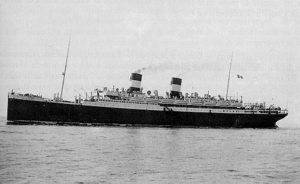SS Roma (1926)
 SS Roma | |
| Career | |
|---|---|
| Name: |
1926-1939: SS Roma 1939-1945: SS Aquila |
| Owner: |
1926-1932: Navigazione Generale Italiana 1932-1939: Italian Line 1939-1943: Italian Navy 1943-1945: Nazi[specify] |
| Port of registry: | 20px Genoa, Italy |
| Builder: | Ansaldo Shipyards, Genoa, Italy |
| Launched: | 26 February 1926 |
| Completed: | September 1926 |
| Fate: | Scultted, raise scrapped in 1951, completed in 1952 |
| General characteristics | |
| Type: |
1926-1939: Ocean liner 1939-1945: Aircraft carrier |
| Tonnage: | 48,502 GRT |
| Installed power: | Geared steam turbines |
| Propulsion: | Twin screws/quadblades |
| Speed: | 20 knots |
SS Roma was a 30,000 gross register ton ocean liner built for the Italian shipping company Navigazione Generale Italiana of Genoa by Ansaldo shipyard in Sestri Ponente. She was the sister ship to MS Augustus. The ship was later transferred to the new Italian Line after the merger of Navigazione Generale Italiana.
History
Following the end of World War I, many shipping companies were waiting to have enough money to build a new liners. Navigazione Generale Italiana ordered two new 30,000 gross tons transatlantic ocean liners to Ansaldo shipyard. The first ship was launched in 1926 and christened Roma. Her interior was decorated by Baroque style that gave her a named Italian floating place. She was equipped with geared steam turbines unlike MS Augustus, her sister ship which was powered by Diesel engines. She had the hull completely steel but her main feature was the power engineer who, thanks all engine consists of eight turbines agents in pairs whose Steam was provided by 13 boilers petroleum, the allowed the speed of 22 knots. Her two funnels were repainted into the Italian Line's colours after her owner company merged together with Lloyd Sabaudo and Cosulich Line to form the new and famous Italian Line. When World War II broke out, she was laid up and later taken over by Italian Navy. She was then refitted and transformed into an aircraft carrier named Aquila. Her speed was increased into 30 knots after the refitting. She was taken over by Nazi in 1943 but was partially scuttled in 1945. After the war ended, her wreckage was raised and towed to La Spezia, where she was scrapped in 1951-1952.
